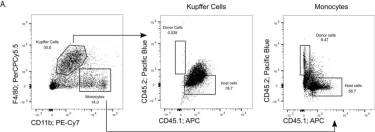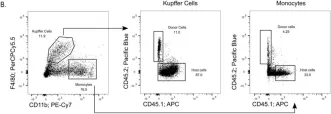Preterm birth (PTB), often preceded by preterm labor, is a major cause of neonatal morbidity and mortality worldwide. Most PTB cases involve intra-amniotic inflammation without detectable microorganisms, termed in utero sterile inflammation, for which there is no established treatment. In this study, we propose homeostatic macrophages to prevent PTB and adverse neonatal outcomes caused by in utero sterile inflammation. Single-cell atlases of the maternal-fetal interface revealed that homeostatic maternal macrophages are reduced with human labor. M2 macrophage treatment prevented PTB and reduced adverse neonatal outcomes in mice with in utero sterile inflammation. Specifically, M2 macrophages halted premature labor by suppressing inflammatory responses in the amniotic cavity, including inflammasome activation, and mitigated placental and offspring lung inflammation. Moreover, M2 macrophages boosted gut inflammation in neonates and improved their ability to fight systemic bacterial infections. Our findings show that M2 macrophages are a promising strategy to mitigate PTB and improve neonatal outcomes resulting from in utero sterile inflammation.
Copyright © 2024 by The American Association of Immunologists, Inc.
Product Citations: 73
In The Journal of Immunology on 1 December 2024 by Garcia-Flores, V., Liu, Z., et al.
-
Immunology and Microbiology
RNA m5C oxidation by TET2 regulates chromatin state and leukaemogenesis.
In Nature on 1 October 2024 by Zou, Z., Dou, X., et al.
Mutation of tet methylcytosine dioxygenase 2 (encoded by TET2) drives myeloid malignancy initiation and progression1-3. TET2 deficiency is known to cause a globally opened chromatin state and activation of genes contributing to aberrant haematopoietic stem cell self-renewal4,5. However, the open chromatin observed in TET2-deficient mouse embryonic stem cells, leukaemic cells and haematopoietic stem and progenitor cells5 is inconsistent with the designated role of DNA 5-methylcytosine oxidation of TET2. Here we show that chromatin-associated retrotransposon RNA 5-methylcytosine (m5C) can be recognized by the methyl-CpG-binding-domain protein MBD6, which guides deubiquitination of nearby monoubiquitinated Lys119 of histone H2A (H2AK119ub) to promote an open chromatin state. TET2 oxidizes m5C and antagonizes this MBD6-dependent H2AK119ub deubiquitination. TET2 depletion thereby leads to globally decreased H2AK119ub, more open chromatin and increased transcription in stem cells. TET2-mutant human leukaemia becomes dependent on this gene activation pathway, with MBD6 depletion selectively blocking proliferation of TET2-mutant leukaemic cells and largely reversing the haematopoiesis defects caused by Tet2 loss in mouse models. Together, our findings reveal a chromatin regulation pathway by TET2 through retrotransposon RNA m5C oxidation and identify the downstream MBD6 protein as a feasible target for developing therapies specific against TET2 mutant malignancies.
© 2024. The Author(s).
-
Mus musculus (House mouse)
-
Genetics
In The Journal of Clinical Investigation on 11 June 2024 by Chung, Y. R., Awakoaiye, B., et al.
Viral vectors are being used for the treatment of cancer. Yet, their efficacy varies among tumors and their use poses challenges in immunosuppressed patients, underscoring the need for alternatives. We report striking antitumoral effects by a nonlytic viral vector based on attenuated lymphocytic choriomeningitis virus (r3LCMV). We show in multiple tumor models that injection of tumor-bearing mice with this vector results in improved tumor control and survival. Importantly, r3LCMV improved tumor control in immunodeficient Rag1-/- mice and MyD88-/- mice, suggesting that multiple pathways contributed to the antitumoral effects. The antitumoral effects of r3LCMV were also observed when this vector was administered several weeks before tumor challenges, suggesting the induction of trained immunity. Single-cell RNA sequencing analyses, antibody blockade experiments, and knockout models revealed a critical role for host-intrinsic IFN-I in the antitumoral efficacy of r3LCMV vectors. Collectively, these data demonstrate potent antitumoral effects by r3LCMV vectors and unveil multiple mechanisms underlying their antitumoral efficacy.
-
FC/FACS
-
Mus musculus (House mouse)
-
Cancer Research
-
Immunology and Microbiology
BRD9 determines the cell fate of hematopoietic stem cells by regulating chromatin state.
In Nature Communications on 15 December 2023 by Xiao, M., Kondo, S., et al.
ATP-dependent chromatin remodeling SWI/SNF complexes exist in three subcomplexes: canonical BAF (cBAF), polybromo BAF (PBAF), and a newly described non-canonical BAF (ncBAF). While cBAF and PBAF regulate fates of multiple cell types, roles for ncBAF in hematopoietic stem cells (HSCs) have not been investigated. Motivated by recent discovery of disrupted expression of BRD9, an essential component of ncBAF, in multiple cancers, including clonal hematopoietic disorders, we evaluate here the role of BRD9 in normal and malignant HSCs. BRD9 loss enhances chromatin accessibility, promoting myeloid lineage skewing while impairing B cell development. BRD9 significantly colocalizes with CTCF, whose chromatin recruitment is augmented by BRD9 loss, leading to altered chromatin state and expression of myeloid-related genes within intact topologically associating domains. These data uncover ncBAF as critical for cell fate specification in HSCs via three-dimensional regulation of gene expression and illuminate roles for ncBAF in normal and malignant hematopoiesis.
© 2023. The Author(s).
-
Mus musculus (House mouse)
-
Stem Cells and Developmental Biology
Replication-attenuated r3LCMV vectors potentiate tumor control via IFN-I
Preprint on BioRxiv : the Preprint Server for Biology on 8 December 2023 by Chung, Y. R., Awakoaiye, B., et al.
Summary Viral vectors are being used for the treatment of cancer. Yet their efficacy varies among tumors and their use poses challenges in immunosuppressed patients, underscoring the need for alternatives. We report striking antitumoral effects by a nonlytic viral vector based on attenuated lymphocytic choriomeningitis virus (r3LCMV). We show in multiple tumor models that injection of tumor-bearing mice with this novel vector results in improved tumor control and survival. Importantly, r3LCMV also improved tumor control in immunodeficient Rag1-/- mice. Single cell RNA-Seq analyses, antibody blockade experiments, and KO models revealed a critical role for host IFN-I in the antitumoral efficacy of r3LCMV vectors. Collectively, these data demonstrate potent antitumoral effects by a replication-attenuated LCMV vector and unveil mechanisms underlying its antitumoral efficacy.
-
Cancer Research
In Int J Mol Sci on 28 February 2022 by Arsiwala, T., Vogt, A. S., et al.
Fig.3.A

-
FC/FACS
-
Mus musculus (House mouse)
Collected and cropped from Int J Mol Sci by CiteAb, provided under a CC-BY license
Image 1 of 2
In Int J Mol Sci on 28 February 2022 by Arsiwala, T., Vogt, A. S., et al.
Fig.3.B

-
FC/FACS
-
Mus musculus (House mouse)
Collected and cropped from Int J Mol Sci by CiteAb, provided under a CC-BY license
Image 1 of 2

